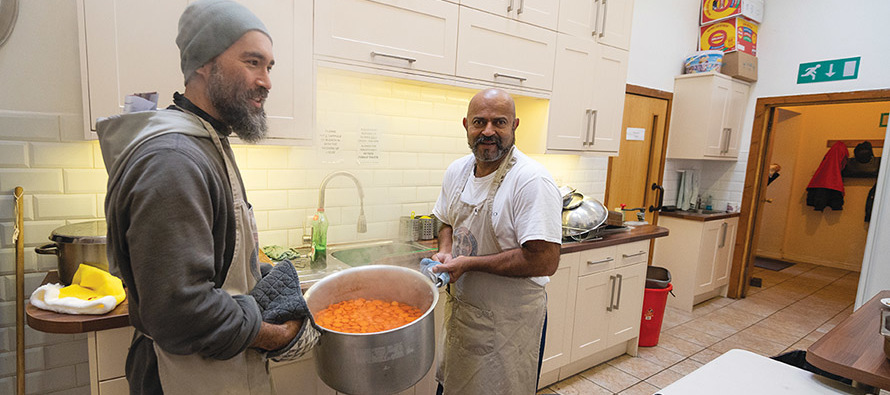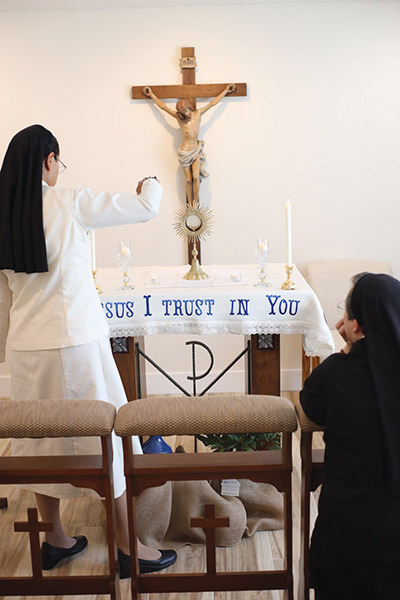The four main types of religious life

A Franciscan friar helps prepare a meal for the needy. Service to others is a hallmark of apostolic religious communities, as well as communities that are a hybrid and include an apostolic element. (Photo: Catholic Church of England and Wales, Flickr)
CONSECRATED LIFE is about revealing God’s loving care and mercy in all sorts of places and circumstances. The variety of religious communities expresses different dimensions of God’s love for people. They reflect the various ways that the gifts of the Holy Spirit have poured forth throughout centuries, be it in quiet contemplation or by proclaiming the gospel to people at the margins of society. As the church document Lumen Gentium (Light of the Nations) puts it, “by their unswerving and humble faithfulness in their chosen consecration [religious] render generous services of all kinds.”
Amid this variety, four basic types of religious communities exist: monastic, cloistered contemplative, apostolic, and missionary. The different types of religious communities spring from a rich history of consecrated life going all the way back to the earliest days of the church.
Monastic life
Within the early church were those who lived a countercultural life of prayer and community in the desert or outside a city. These groupings were the origins of what is known today as monastic religious life. Members of monastic institutes are called monks and nuns. They live a contemplative life where prayer and communal living are central, and they undertake work or ministry that fits their way of life. They may be either enclosed or free to minister outside the monastery, but they live “in stability,” (to use their language) to a particular monastic community. Within this community, they follow regular times of communal prayer throughout the day, based on the psalms and prayers that make up the long-standing church prayer practice called the Divine Office. While not all monastics are Benedictines, most follow some form of the Rule of St. Benedict, a text written in the year 529 that describes monastic virtues such as obedience and humility and lays out guidance for daily living.
Examples of monastic communities include Benedictines, Augustinians, Norbertines, Visitation Nuns, and Bridgittines.

Cloistered contemplative life
This way of life is a variant of the monastic form. Cloistered communities maintain the practice of withdrawing from “the world” and from outside ministry to live a life entirely dedicated to contemplation. Members rarely leave the property of their monasteries. Here’s how Verbi Sponsa, a 1999 church document about contemplative life, describes it: “In a specific and radical way, cloistered contemplatives conform to Christ Jesus in prayer on the mountain and to his Paschal Mystery, which is death for the sake of resurrection…. Their life is a reminder to all Christian people of the fundamental vocation of everyone to come to God.” Contemplative nuns and monks dedicate periods of the day to silence, solitude, Mass, and the Divine Office. Most also engage in on-site work to support themselves, such as growing food and making altar breads.
Examples of cloistered contemplatives are Discalced Carmelites, Poor Clares, Cistercians, Trappists, and various Benedictine and Dominican communities of priests and nuns.
Apostolic life
A third major type of consecrated life is apostolic religious congregations, which developed later than the first two types and describes most religious institutes. Apostolic groups are focused on outward ministry. They often exercise charity as expressed in Matthew 25: Feed the hungry, visit the sick and imprisoned, shelter the homeless, bury the dead, and clothe the naked. The nature of apostolic religious communities is love and service in the name of the church. The gifts, or charisms, these religious possess differ according to the graces each is allotted. Administrators have the gift of leadership, teachers can impart new knowledge, preachers have the gift of stirring speech, and so on.
For members of these religious institutes, ministry springs from an intimate union with God, nurtured in community and prayer. This love is transmitted to those they serve.
Examples of apostolic communities include Paulists, Jesuits, Vincentians, Sisters of Mercy, Sisters of Charity, Sisters of St. Joseph, Dominicans, Christian Brothers, Alexian Brothers, Priests of the Sacred Heart, Congregation of Holy Cross, Providence Sisters, Presentation Sisters, Marists, and Marianists.
Missionary life
The fourth main type of consecrated life is missionary religious institutes. These institutes are committed to proclaiming the gospel, strictly following Jesus’ commission to “Go into the whole world and proclaim the gospel to every creature” (Mark 16:15). In keeping with their calling of evangelization, missionary men and women frequently dedicate their lives to humanitarian projects in different countries, underserved areas, or among non-evangelized people, respecting the diversity of cultures, races, and faith traditions. The missionary vocation can involve risk-taking, sometimes proclaiming the gospel in difficult environments.
Examples of missionary institutes include the Divine Word Missionaries, Maryknolls, Spiritans, Missionaries of the Precious Blood, Missionaries of Charity, Combonis, and Columbans.
I’ve focused here on four main types of consecrated life—monastic, cloistered contemplative, apostolic, and missionary—but it’s helpful to know that some groups are a hybrid of two or more of these types. The community I belong to, Sister Servants of the Blessed Sacrament, is not precisely any of these four types but rather a mix of contemplative and apostolic.
As you learn about these different forms of consecrated life, remember, the Lord calls each of us by name. I encourage you to seek the way of life that best speaks to your heart and talents. Do not be afraid to give your all to the Lord! And remember, God does not call the qualified, but God qualifies those who are called.
A version of this article first appeared as a presentation in the NRVC webinar series “Religious Life Today: Learn it! Love it! Live it!” Find more about the series here: nrvc.net/webinars.
Related article: VocationNetwork.org, “9 things religious life has to offer.”
Tags
Related
- Religious making a difference
- Religious seekers in legal limbo
- Mercy meets at the border
- Religious life: The call continues
- Vocation Basics: Essentials for the vocation journey
- Community life: A place to call home
- A charism encourages a caring ministry
- Our newest religious possess an age-old Christian virtue: hope
- Celibacy steeped in a whole lot of love
- Benedictines believe in balance Read More
Most Viewed
- Find your spirituality type quiz
- FAQs: Frequently asked questions about vocations
- Celibacy quiz: Can you live a celibate life?
- Resources for older discerners or those with physical and developmental differences
- About Vocation Network and VISION Guide


